Are you a Quiet Speculation member?
If not, now is a perfect time to join up! Our powerful tools, breaking-news analysis, and exclusive Discord channel will make sure you stay up to date and ahead of the curve.
Welcome back for the December metagame update. This month saw two large-scale Grand Prix delineate an extremely diverse metagame. Perhaps it's just my own personal bias, but I believe Modern is in a great spot right now—healthy, diverse, with interactive games and relevant decisions in deckbuilding and sideboard construction. This is the "metagame to beat" as we gear up for Pro Tour Rivals of Ixalan in early February. I fully expect all the major decks in this update to make a serious bid on the biggest stage, barring something broken arising unexpectedly like Eldrazi Winter. That said, when the pros get their hands on an eternal format (especially after several years of absence), expect them to challenge assumptions, innovate, and ruthlessly weed out the lower-tier chaff. While this metagame is clearly diverse, I also think there's a clear upper tier with a better chance of success. After covering the data itself, I'll close with my thoughts on that upper tier and make a few predictions for the Pro Tour.
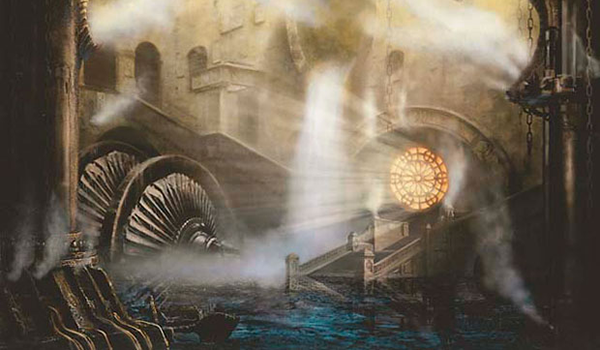
This month we're seeing what I believe are two distinct metagames developing on MTGO and in paper. Since the November update Tier 1 has changed only slightly, welcoming Gx Tron to its ranks as the containing decks shifted around in order. What's more interesting is how the rest of Tier 2 and Tier 3 have shaken out. Deciding where to draw the line between these was very challenging this month. At first I thought this was a function of a flat power level in the lower-tier decks that was blurring the lines between Tier 2 and 3. Upon further inspection, I think a better explanation is that the online metagame is reacting to some pretty radical differences originating from the presence of Gifts Storm.
I'll lay out that argument in more detail below. First, though, let's revisit the methods we use here at Nexus and go over the metagame data itself.
Data Collection Methods
I made one major change to data collection this month, which was to finally jettison the Day 2 component entirely. The Day 2 metagame breakdowns were initially intended to incorporate the idea of "conversion rate" in some faculty into our analysis. They accomplished this admirably until Wizards stopped reporting the Day 2 data for Grand Prix. Since that time, I've tried to operationalize conversion rate by cobbling together an index of other data points along with past Day 2 data and the breakdowns from Star City Games Opens. This process has been ad hoc, cumbersome, and seriously lacking in rigor. This month, for example, we would have been working with Day 2 data from only the SCG Roanoke Open. It really doesn't make sense to weight a single event as a separate branch of our metagame update. Moving forward this will no longer form part of our analysis, until and unless more data of this kind becomes readily available.
The paper data for December comprise 604 decklists across 79 different tournaments. The high-profile events from these data are two Grand Prix in Oklahoma City and Madrid, a Star City Games Invitational, and the SCG Roanoke Open and Classic from that same weekend. The treatment of both GP Madrid and the SCG Invitational merits further discussion as they had non-standard tournament structures.
GP Madrid was Team Unified Constructed, which means competitors on a given team could not share any cards across decklists. This incentivizes the selection of decks with little overlap across the format (Affinity, RG Valakut), and makes certain combinations of high-tier decks nigh impossible (Storm plus Grixis Shadow). It also means that one deck can perform poorly and nonetheless advance on the back of its teammates' record. That said, top finishers at GP Madrid had to slog through 14 rounds of Modern, and this event should still carry significant weight. Wizards reported all decklists with records of 12-1-1 or better—all are included in the regular paper data, but only the Top 4 teams were considered a "Major Top 8 finish."
As a split-format event, the SCG Invitational presents slightly different problems. Including Top 8 decklists would introduce Standard performance as a confounding variable. Instead, data consisted of all decks earning 19 points or more (6-1-1), which were entered as a normal paper event but didn't contribute to the Major Top 8 data.
Our MTGO data covers 379 decks from 38 events of three different types: Competitive Leagues, Modern Challenges, and PTQs.
- Competitive Leagues - The daily 5-0 decklists published by Wizards. Remember that their current algorithm necessitates the appearance of different decks for each day, so there's a slight bias towards a more diverse metagame.
- Modern Challenges - One for each week of the month (five in total for December). These represent the higher-tier, more competitive tournaments on MTGO, offsetting somewhat the bias of Competitive Leagues. Top 32 finishes (down to a 5-3 record) were included.
- PTQs - There were two PTQs for the month of December, on the 11th and the 18th. Again the Top 32 is included. In November I actually treated these as Major Paper Top 8s. This month they appeared to skew the point assignments, so I went back to considering them MTGO-only data points.
The Metagame
Onto the numbers themselves. For a comprehensive explanation of how these are calculated, check out Sheridan's original description on the Top Decks page. Soon I hope to revisit some of the nitty-gritty to double-check that my updated spreadsheet ported over the old formulas correctly, and in particular that our margin of error is being calculated correctly. That will have to wait for a subsequent date, however. For now, just remember that our sample here doesn't paint an exact picture of the metagame, but an approximation. Margins of error shouldn't be huge for the top decks, but they will increase the farther down the standings we go. So make sure to take your favorite Tier 3 deck's metagame share of 0.5% (or whatever) with a grain of salt.
The complete December data is available in an easily readable form here.
Tier 1: 12/1/17 - 12/31/17
| Deck | Overall Metagame % | Paper % | MTGO % |
|---|---|---|---|
| Grixis Shadow | 5.5% | 4.5% | 7.1% |
| [archetype]Burn[/archetype] | 5.4% | 6.0% | 4.5% |
| [archetype]Gx Tron[/archetype] | 5.2% | 6.1% | 3.7% |
| Jeskai Tempo | 4.8% | 5.0% | 4.5% |
| [archetype]RG Valakut[/archetype] | 4.7% | 6.1% | 2.4% |
| [archetype]Eldrazi Tron[/archetype] | 4.6% | 4.6% | 4.5% |
| [archetype]Affinity[/archetype] | 4.5% | 5.1% | 3.4% |
| [archetype]Humans[/archetype] | 4.5% | 2.8% | 7.1% |
| [archetype]Gifts Storm[/archetype] | 4.4% | 2.6% | 7.1% |
| [archetype]Counters Company[/archetype] | 3.7% | 4.6% | 2.1% |
Our Tier 1 for December consists of November's crew plus newcomer Gx Tron. In November we saw a relatively flat distribution of metagame share, with the bottom six decks in Tier 1 all hovering between 4.5% and 5.0%. Three decks—Affinity, Gifts Storm, and Jeskai Tempo—stood solidly atop this ranking, with shares ranging from 7.0% to 5.5%. In December we see Tier 1 flatten out even more, forming a pretty smooth gradient from Grixis Shadow on down. No deck is breaking 6% of metagame share, a strong sign of a diverse and healthy format.
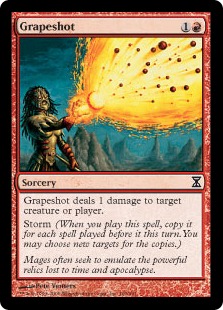 However…this picture does start to break apart if we isolate the MTGO data. I've discussed in past articles how MTGO often represents an advanced state of the metagame due to its regularity of events and high level of competition, both of which encourage rapid iteration. Here we see three decks at the top of the MTGO metagame, each at 7.1%: Humans, Grixis Shadow, and Gifts Storm. Behind them the next highest percentage is a pretty precipitous drop to 4.5%.
However…this picture does start to break apart if we isolate the MTGO data. I've discussed in past articles how MTGO often represents an advanced state of the metagame due to its regularity of events and high level of competition, both of which encourage rapid iteration. Here we see three decks at the top of the MTGO metagame, each at 7.1%: Humans, Grixis Shadow, and Gifts Storm. Behind them the next highest percentage is a pretty precipitous drop to 4.5%.
I believe the key to understanding this dynamic is Gifts Storm. Storm is, to be quite simple, the most broken deck available in Modern right now—it preys on lower-tier decks like no other, presenting an extremely powerful game plan that defies interaction and wins through disruption. To defeat Storm, a mere hate piece or two usually isn't sufficient—you must also present a fast clock yourself. Try to interact too much and Storm will craft a late game where it can fight through just about anything. On the other hand, go all-in on aggression in an attempt to race and you may find yourself on the short end of the turn-three-kill stick. The decks best positioned to attack Storm present both a fast clock and significant disruption. Of these, Humans and Shadow are the most powerful options, more than capable of combating the rest of the field as well.
So I'm inclined to say Storm is warping the MTGO meta around it to some extent—as we'll see below, I believe this is effect is influencing the lower tiers as well.
Tier 1 Changes: December 2017
| Deck | % Change November to December | Overall Meta % 12/1 - 12/31 | Overall Meta % 11/1 - 11/30 |
|---|---|---|---|
| Grixis Shadow | +0.8% | 5.5% | 4.7% |
| [archetype]Burn[/archetype] | +0.5% | 5.4% | 4.9% |
| [archetype]Gx Tron[/archetype] | +1.9% | 5.2% | 3.3% |
| Jeskai Tempo | -0.7% | 4.8% | 5.5% |
| [archetype]RG Valakut[/archetype] | +0.2% | 4.7% | 4.5% |
| [archetype]Eldrazi Tron[/archetype] | -0.2% | 4.6% | 4.8% |
| [archetype]Affinity[/archetype] | -2.5% | 4.5% | 7.0% |
| [archetype]Humans[/archetype] | -0.4% | 4.5% | 4.9% |
| [archetype]Gifts Storm[/archetype] | -1.3% | 4.4% | 5.7% |
| [archetype]Counters Company[/archetype] | -1.2% | 3.7% | 4.5% |
Looking to the changes since November, we see a little shuffling around of relative rankings but most decks staying more or less put. The big stories here are Affinity and Gx Tron.
Affinity is following a pretty clear pattern of online players moving away from the archetype as the paper population lags behind (but still follows suit). Its November paper and MTGO shares were 7.5% and 4.8% respectively, so this decline was already in progress then. In December Affinity's paper share of 5.1% has mostly caught up to the November MTGO numbers. 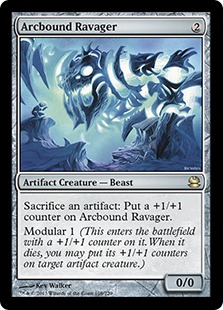 Meanwhile, online players expressed even more skepticism in the archetype as the MTGO share fell an additional 1.4%. It's fair to say this isn't the best time for the robots, but don't write them off entirely. A deck as brutally efficient as Affinity never truly dies, and if Mox Opal, Arcbound Ravager, & Co. don't put any pilots into the Top 8 of PT Rivals I'll be surprised.
Meanwhile, online players expressed even more skepticism in the archetype as the MTGO share fell an additional 1.4%. It's fair to say this isn't the best time for the robots, but don't write them off entirely. A deck as brutally efficient as Affinity never truly dies, and if Mox Opal, Arcbound Ravager, & Co. don't put any pilots into the Top 8 of PT Rivals I'll be surprised.
While Affinity was going down, Gx Tron was coming up. Strangely enough, the MTGO and paper share of this archetype seem to have swapped places since November. Last month it was 2.3% in paper, 6.4% on MTGO. In December it was 6.1% and 3.7% respectively. Note that this switch is more than enough to push it up a tier, as the paper n is higher (and thus carries more weight).
So what gives? Honestly, I'm at a bit of a loss on this one. Tron was notably one of the breakout decks at GP Oklahoma City, but people were picking it up for all kinds of other tournaments too. At the same time the online players were abandoning it. Weird. If you have some inkling of why this would be the case, I'd love to hear about it in the comments.
Tier 2: 12/1/17 - 12/31/17
| Deck | Overall Metagame % | Paper % | MTGO % |
|---|---|---|---|
| Abzan | 2.7% | 3.0% | 2.4% |
| Jund | 2.6% | 3.1% | 1.8% |
| UW Control | 2.4% | 3.1% | 1.3% |
| Dredge | 2.3% | 1.0% | 4.5% |
| [archetype slug="5-color shadow"]Traverse Shadow[/archetype] | 2.2% | 1.5% | 3.4% |
| Eldrazi and Taxes | 2.1% | 2.3% | 1.8% |
| UR Breach | 1.8% | 1.3% | 2.6% |
| Mardu Tokens | 1.6% | 0.8% | 2.9% |
| RG Ponza | 1.6% | 1.3% | 2.1% |
| Lantern Control | 1.5% | 1.3% | 1.8% |
| Bogles | 1.5% | 1.2% | 2.1% |
| Ad Nauseam | 1.4% | 1.2% | 1.8% |
| Death and Taxes | 1.4% | 2.0% | 0.5% |
| Elves | 1.3% | 2.0% | 0.3% |
As I alluded to earlier, there was a high degree of variance in the Tier 2 and Tier 3 archetypes that made drawing the line between them tough. This was due to a significant gulf between the MTGO and Paper metagames taken separately, indicating that each is responding to different strategic incentives. To understand what this means for our tiers this month, it will serve to examine some of the more technical details behind tiering calculations.
The metagame spreadsheet uses a point system to assign each archetype a total rank according to various criteria. These essentially break into three categories: MTGO Tier, Paper Tier, and Major Top 8 finishes. The Major Top 8 finishes are easiest to understand—archetypes earn 2 points for each Top 8, 1 point for each Top 16. This only applies for events we've labeled as "major" (for this month, both Grand Prixs and the SCG Classic/Open pairing from Roanoke).
Tiers for MTGO and Paper metagames are calculated using the standard deviation of archetype percentage. That is to say, we calculate a baseline percentage (derived from the mean) of all archetypes in the data, then measure how far above that baseline a given deck varies. Tier 3 means just above the baseline, Tier 2 means one standard deviation above, and Tier 1 means two standard deviations above. Note this is done independently for both the paper and MTGO data—from there tiered decks are assigned points depending on where they landed in both metagames, which is added to the Major Top 8 points for a final score.
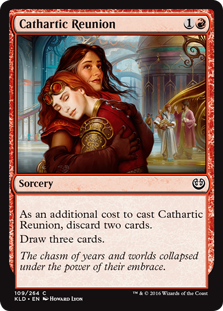 Finally, this same calculation is done for the entire data set combined. That's what yields the final percentages of our metagame picture, but the format-wide tierings are calculated using the point score instead. That means they won't always correlate exactly. Most months there are several decks with point scores indicating a given tier that doesn't mesh with its total percentage. These are usually the result of a rogue deck top-eighting a major event (which, remember, will earn it 2 points regardless of total metagame percentage). For these decks I manually adjust their tier up or down before publishing the final results to better reflect the percentages.
Finally, this same calculation is done for the entire data set combined. That's what yields the final percentages of our metagame picture, but the format-wide tierings are calculated using the point score instead. That means they won't always correlate exactly. Most months there are several decks with point scores indicating a given tier that doesn't mesh with its total percentage. These are usually the result of a rogue deck top-eighting a major event (which, remember, will earn it 2 points regardless of total metagame percentage). For these decks I manually adjust their tier up or down before publishing the final results to better reflect the percentages.
What's weird this month is we had tons of decks like this in Tier 2 and Tier 3. It was enough that figuring out where to draw the line was difficult, and somewhat arbitrary. What this means is that the differences between the Paper, MTGO, and Major Top 8 metagames were significantly higher than normal. We already saw above how Tier 1 decks on MTGO are presenting a more polarized format than their paper counterparts. In the lower tiers it's much harder to discern a clear pattern, but a lot of archetypes are still posting huge differences between the two formats. You can see this discrepancy clearest in Dredge, Traverse Shadow, Mardu Tokens, Death & Taxes, and Elves—in addition to yet more decks in Tier 3.
So, what I think we're seeing is essentially two different Modern metagames, where the constraints placed on decks in each is markedly different. If I'm right that Storm is warping the online meta, that could easily create cascading effects down to other archetypes in the lower tiers. Whatever the cause, it's clear that players on MTGO are navigating a very different environment—more so than usual—than what you may be seeing at your local paper events.
Per Archetype Notes
- Dredge. This deck presents the biggest gap between its paper and MTGO shares at a whopping 3.5%. November painted a similar picture for the archetype, and I recall seeing this pattern during its pre-ban heyday as well. Is it possible people are just avoiding this deck as an "unfun" option in less competitive environments? My guess is simply that players are underrating its power level, as I think that has generally been the case, but it is likely being influenced by the differences in the online meta as well.
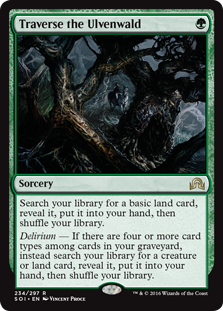 Traverse Shadow. Reid Duke has been recording games with all kinds of BGx over at Channel Fireball, including all the Shadow variants. He makes a strong case for the idea that Traverse the Ulvenwald builds are fundamentally the same deck, and I'm inclined to adopt his terminology. The majority of these builds are the typical 5-Color Shadow deck with Stubborn Denial in the main and Lingering Souls in the sideboard, but the December data also includes 4-Color builds and one Jund deck.
Traverse Shadow. Reid Duke has been recording games with all kinds of BGx over at Channel Fireball, including all the Shadow variants. He makes a strong case for the idea that Traverse the Ulvenwald builds are fundamentally the same deck, and I'm inclined to adopt his terminology. The majority of these builds are the typical 5-Color Shadow deck with Stubborn Denial in the main and Lingering Souls in the sideboard, but the December data also includes 4-Color builds and one Jund deck.
- Bogles. To my knowledge Bogles has never been as high as Tier 2 in our metagame standings. It jumped up about half a percent from its November shares, mostly from paper players taking a cue from online players and picking up the deck.
- Mardu Tokens. Here we have another deck starting to bleed from online to paper, jumping up a tier in the process. Bedlam Reveler packs a serious punch as one of the best delve spells still legal in the format. That said, I'm not sure I'm in love with this deck's overall power level, and I question if it's just a worse version of black midrange standbys Abzan and Jund.
Tier 3: 12/1/17 - 12/31/17
| Deck | Overall Metagame % | Paper % | MTGO % |
|---|---|---|---|
| As Foretold Living End | 1.2% | 0.2% | 2.9% |
| [archetype]Merfolk[/archetype] | 1.2% | 1.8% | 0.3% |
| 8Rack | 1.2% | 2.0% | 0.0% |
| Hollow One | 1.2% | 1.2% | 1.3% |
| Living End | 1.1% | 1.8% | 0.0% |
| Griselbrand | 1.0% | 0.2% | 2.4% |
| Jeskai Control | 1.0% | 1.2% | 0.8% |
| Gx Eldrazi | 1.0% | 1.3% | 0.5% |
| GW Company | 0.8% | 0.8% | 0.8% |
| Mono U Tron | 0.8% | 0.3% | 1.6% |
| [archetype]Infect[/archetype] | 0.8% | 0.7% | 1.1% |
| Amulet Titan | 0.7% | 0.5% | 1.1% |
| UR Kiki | 0.7% | 0.5% | 1.1% |
| Goblins | 0.6% | 0.5% | 0.8% |
| Knightfall | 0.6% | 0.8% | 0.3% |
| UW Midrange | 0.6% | 0.8% | 0.3% |
| RW Prison | 0.5% | 0.8% | 0.0% |
| Grixis Control | 0.5% | 0.5% | 0.5% |
Here in Tier 3 we see more archetypes with large differences in online/paper shares, with a good number posting practically 0% or close to it in one of the two metagames. Yeesh. Your MTGO-only Tier 3 consists of As Foretold Living End, Griselbrand, and Mono U Tron, while the paper-only contenders are Merfolk, 8Rack, and traditional Living End. Note that Elves above in Tier 2 follows a similar pattern, and easily could have been lumped in with Tier 3.
Remember that Tier 3 tends to go through a ton of churn each month, and December was no different. Being aware of these decks for your competitive ventures is advisable—worrying about them is not. I don't expect these decks to put up Pro Tour Top 8s, unless one of the major teams manages to break one of the newer decks like As Foretold or BG Eldrazi.
Per Archetype Notes
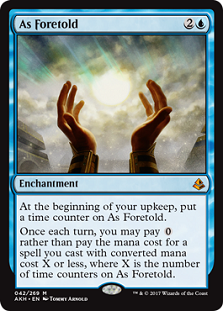 As Foretold. Over the past month this deck has been all the rage in the hands of a number of streamers (including our own Ryland). It's always exciting when a brand-new archetype gets enabled by some unique printing like As Foretold, and this deck appears to have real legs. Resolving Ancestral Recall for zero mana ain't no joke, folks. Neither is running Living End without constraints on your ability to play interactive spells like Remand or Serum Visions. I don't think we've seen the last of this archetype.
As Foretold. Over the past month this deck has been all the rage in the hands of a number of streamers (including our own Ryland). It's always exciting when a brand-new archetype gets enabled by some unique printing like As Foretold, and this deck appears to have real legs. Resolving Ancestral Recall for zero mana ain't no joke, folks. Neither is running Living End without constraints on your ability to play interactive spells like Remand or Serum Visions. I don't think we've seen the last of this archetype.
- Merfolk. First Merfolk went green, then they went back. There were scant UG Merfolk decks in December's data, for whatever reason. I expect that to be short-lived, however, as the new two-mana lord from Rivals of Ixalan is likely to cement the tribe's forest affiliations for the foreseeable future.
- Hollow One. As I predicted last month, the wonky red-based discard deck has fallen from its brief time in the sun in Tier 2 territory. Builds of this deck are nowhere near ironed out, so there may still be a potent strategy here waiting to be tuned.
- Gx Eldrazi. This category includes the old Bant Eldrazi decks, which still show up semi-regularly if in much lower numbers than their younger brother Eldrazi Tron. It also includes a number of different-colored builds (Temur, RG, and BG), which are built around the same shell of Ancient Stirrings, Birds of Paradise/Noble Hierarch, and Eldrazi Temple. Rob wrote about some known pros that have been experimenting with the shell. Could one of these updated versions with new splash colors be a breakout deck at the PT?
Pro Tour Predictions
In the introduction I stated that a higher competitive echelon of decks in Modern can be discerned. What I'm referring to with this phrase is the trio of decks posting the highest precentage on MTGO: Grixis Shadow, Humans, and Storm. As we've seen, however, this more dominant performance on MTGO isn't translating to the paper metagame. I think there are two reasons for this.
First, my hypothesis is that Storm is being played in significantly lower numbers in paper. This is the classic example of a deck that grinders and pros gravitate towards while the population at large eschews. From my own anecdotal experience speaking to local players about the archetype, I believe that much of the population at large is underestimating its power. Skill level is a real impediment too. 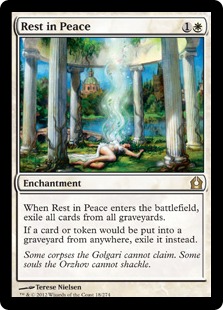 Storm is extremely challenging to pilot well and mistakes can be very costly, especially in post-board games. If you're playing Gifts Storm at, say, 75%, there's a good chance the hate pieces will take you down after sideboarding. The feel-bads of getting Rest in Peaced into oblivion may well lead you to conclude that hate is too prevalent to play Storm right now. Meanwhile, the MTGO players, many of whom will have many more games under their belt and a more competitive environment in general to fight through, are proving that contention mistaken.
Storm is extremely challenging to pilot well and mistakes can be very costly, especially in post-board games. If you're playing Gifts Storm at, say, 75%, there's a good chance the hate pieces will take you down after sideboarding. The feel-bads of getting Rest in Peaced into oblivion may well lead you to conclude that hate is too prevalent to play Storm right now. Meanwhile, the MTGO players, many of whom will have many more games under their belt and a more competitive environment in general to fight through, are proving that contention mistaken.
The second reason for the divergence, I believe, lies in the less predictable nature of paper metagames. Modern is famously the play-what-you-know format. While this is certainly true across the board (and quite noticeable when compared to the often-stagnant Standard), the phenomenon often appears more marked in paper. The MTGO hive mind solves formats fast, switches decks rapidly, and puts enormous pressure on Tier 2 and Tier 3 decks to put up or get out. Against linear decks like Storm, Affinity, Burn, etc., this less diverse metagame might not have a huge effect—but the same isn't true against the likes of Humans and Shadow. Those two decks aim to interact, and if they're extremely well geared to take down Storm, they can fail against some of the more fringe strategies. In a certain sense Humans and Shadow are metagame decks, preying on the abundance of Storm in the online meta but losing some of their luster when their preferred target becomes less common.
That said, it would be easy to overstate this effect. Remember our highest share on the MTGO standings is 7.1%—that's several percentage points below Infect, Dredge, and Jund at their respective heights last year. Even the MTGO metagame is uncharacteristically diverse for Modern right now. That bodes well for the format's health and its return to the Pro Tour stage in February.
Given what I've seen in the December data, here are my predictions for Bilbao:
- The field at large will be highly diverse. Even accounting for a slightly more homogeneous MTGO metagame, the Modern format is just very diverse right now. I expect this to be carried over to the Pro Tour. It might seem like the higher skill level at the PT would lead to a more solved metagame, but I don't think that will be the case. Skill is only one factor behind the "solved" MTGO metagame—Pro Tour competitors will be faced with a much less transparent field that will be very hard to metagame against. The split-format nature of Pro Tours further compounds this: any player whose specialty is Limited may indeed select a constructed deck that fits their play style over one they believe is better positioned. Given this uncertainty, I expect most competitors to follow the age-old format adage: play what you know.
- The Top 8 will reflect this diversity. I expect this diversity to translate to the Top 8 as well, with six or seven different archetypes and no more than two of the same type. Every deck from Tier 1 is a serious candidate for a Top 8 berth, and I believe most slots will be occupied by these decks. But I expect to see a few lower-tier decks make a showing as well. My picks for the most powerful Tier 2 options are Dredge, Lantern Control, UR Breach, and UW Control.
 Storm, Shadow and Lantern Control will be played in higher numbers. These three decks are difficult to pilot, and easy to write off if your experience facing them is against weaker opponents. Expect the pros not to shy away from the challenge. I've already gone on record with my belief that Gifts Storm is the most powerful archetype in the abstract, and the deck best suited to taking down the format at large. I'm slightly less confident in Shadow's lasting power, but I still think we'll see a high number of pros adopt it for Bilbao (note I'm including the Traverse variants here). As for Lantern Control, this is another deck pros sing the praises of while most players yawn and look away. The newest addition to the deck, Whir of Invention, has done wonders for its consistency. Remember, this was one of the best performing decks at GP Oklahoma City until it ran afoul of the Gx Tron decks at the top tables. If that archetype is played in lower numbers, it could be Lantern's time to shine.
Storm, Shadow and Lantern Control will be played in higher numbers. These three decks are difficult to pilot, and easy to write off if your experience facing them is against weaker opponents. Expect the pros not to shy away from the challenge. I've already gone on record with my belief that Gifts Storm is the most powerful archetype in the abstract, and the deck best suited to taking down the format at large. I'm slightly less confident in Shadow's lasting power, but I still think we'll see a high number of pros adopt it for Bilbao (note I'm including the Traverse variants here). As for Lantern Control, this is another deck pros sing the praises of while most players yawn and look away. The newest addition to the deck, Whir of Invention, has done wonders for its consistency. Remember, this was one of the best performing decks at GP Oklahoma City until it ran afoul of the Gx Tron decks at the top tables. If that archetype is played in lower numbers, it could be Lantern's time to shine.
- Humans will underperform. If Shadow and Lantern are being underrated, I think Humans is a little too hyped right now. It's good against Storm, no doubt, and it can pack a wallop in other matchups too. I just think it's lacking the abstract power to fight through its bad matchups. At the end of the day, Modern is a format that rewards linearity and explosiveness. Humans can't really boast either of those things, and its interaction plan is conspicuously lacking in the best disruption piece Modern has to offer, Thoughtseize. For those looking to position themselves against Storm with an interactive counterstrategy, I believe Shadow will prove the superior option that sacrifices the least in other matchups.
So, that's what I think we'll see at Pro Tour Rivals of Ixalan. I myself will be in attendance trying to compete for the glory as well, so wish me luck!
What are your thoughts on the December metagame? Did I get it right in my analysis of the differing MTGO and paper metagames? Or is something other than Storm to blame for the gap? Will this be a highly diverse Pro Tour that validates Wizards's choice to bring the format back to the big stage, or will the pros break it open? Let me know in the comments, and thanks for reading.



